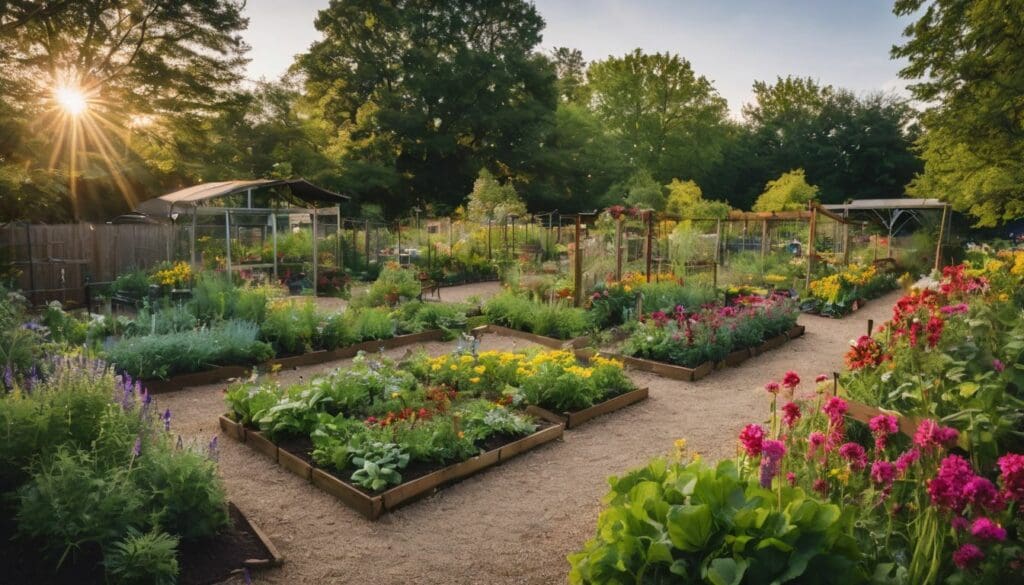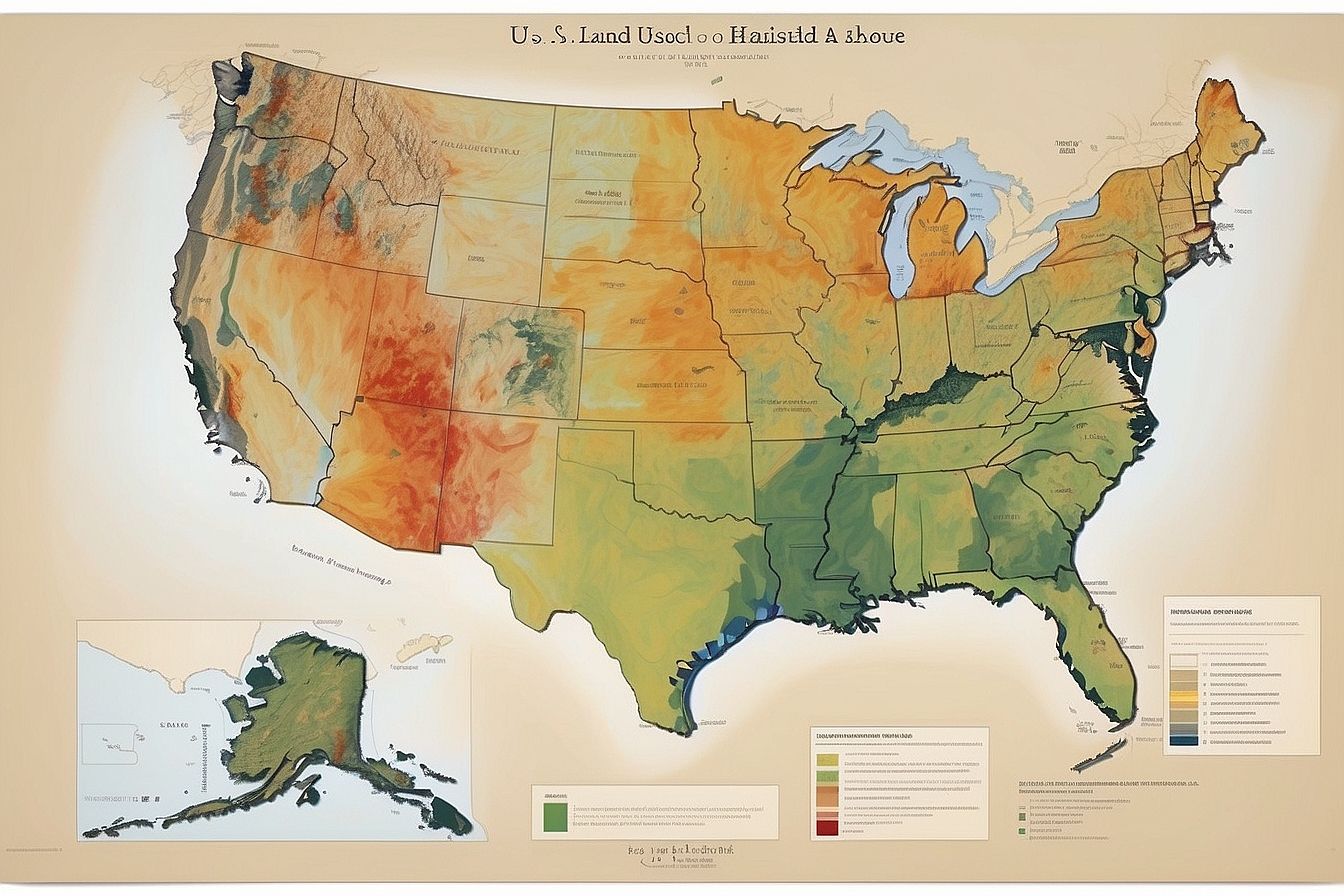As we stand in our gardens, admiring the view, it’s evident that a verdant lawn is not the sole marker of horticultural splendour. It’s a common battle to craft an outdoor sanctuary that marries aesthetic charm with environmental responsibility and I find myself amongst those striving to achieve just that.
Armed with one enlightening detail – sustainable gardens can significantly reduce water use by upwards of half – we’re embarking on an exploration into how eco-conscious landscaping does more than satiate our visual appetite; it actively contributes to healing the wounds inflicted upon our dear planet.
So let us unearth the ecological wonders beneath your very feet as you venture further into this narrative!
Key Takeaways
- Sustainable landscaping is a way of creating beautiful gardens that are also kind to the Earth, using less water and fewer chemicals.
- It includes planting native species which need less care and helps local wildlife thrive in our backyards.
- By planning our outdoor spaces thoughtfully, we can make them cooler places to be during hot weather, helping to save energy.
- Eco-friendly gardening reduces waste by recycling materials and choosing long-lasting products for our garden designs.
- Communities get together through sustainable landscaping, enjoying nature while looking after the environment.
Understanding Sustainable Landscaping
Sustainable landscaping involves using environmentally friendly practices and designs to create outdoor spaces that are both visually appealing and ecologically sound. It aims to reduce the environmental impact of construction and maintenance while enhancing biodiversity and ecosystem services.
Definition of sustainable landscaping
We see sustainable landscaping as a practice that designs, creates, and maintains outdoor spaces in ways that are kind to our planet. It involves using techniques and materials that help conserve water, reduce waste, and lower the environmental impact of gardens and green spaces.
By choosing drought-resistant plants and eco-friendly yard practices, we ensure our landscapes thrive with minimal resources.
As experts in this field, we integrate conservation landscaping principles into every project. This means promoting biodiversity by selecting plant species native to the area, which often require less maintenance and water than exotic varieties.
We also focus on reducing chemical use, favouring natural alternatives whenever possible for a healthier ecosystem. Our goal is always to create sustainable garden designs that support local wildlife while offering beautiful green outdoor living spaces for people to enjoy.
Key principles
Sustainable landscaping involves incorporating eco-friendly practices into outdoor design. It’s about using environmentally sustainable horticulture and responsible landscaping techniques. Let’s delve into the key principles of sustainable landscaping:
- Minimising water usage: Efficient irrigation systems and drought-resistant plants help reduce water consumption.
- Soil health preservation: Using organic compost, mulch, and avoiding chemical fertilisers supports healthy soil ecosystems.
- Biodiversity enhancement: Incorporating diverse plant species and habitats fosters biodiversity and ecosystem services.
- Energy conservation: Strategic placement of trees and shrubs can provide shade and reduce the need for excessive cooling.
- Reduction of waste: Implementing recycling, reusing materials, and choosing durable products minimises environmental impact.
Role in building design
When considering the role of sustainable landscaping in building design, it’s important to recognise its potential to enhance the overall environmental performance of a property. Integrating sustainable landscaping practices such as using drought-resistant plants, incorporating green spaces, and implementing eco-friendly yard maintenance not only improves visual appeal but also contributes to climate change mitigation and reduction of environmental impact.
By embracing environmentally friendly landscaping techniques, green building designs can be further enhanced to create eco-conscious outdoor spaces that prioritise sustainability.
Incorporating sustainable landscape design into building projects allows for the creation of environmentally sustainable outdoor spaces that support conservation efforts while reducing negative impacts on the ecosystem.
Impact on the environment
Sustainable landscaping has a significant impact on the environment. By incorporating eco-friendly yard practices and using drought-resistant plants, we can reduce environmental impact and enhance biodiversity.
Sustainable outdoor design plays a crucial role in reducing the use of water resources and minimising construction site enhancement, which ultimately contributes to earth-friendly landscaping.
Furthermore, environmentally sustainable landscaping nurtures community engagement and well-being by creating eco-conscious outdoor spaces that support conservation efforts. It also promotes green landscaping initiatives while ensuring sustainable yard maintenance practices are in place, all contributing to environmental impact reduction and enhancing ecosystem services.
Benefits of Sustainable Landscaping
Enhancing biodiversity and ecosystem services, nurturing community engagement and well-being, and promoting environmental benefits are just a few of the advantages of sustainable landscaping.
Want to learn more about how ecoconscious landscaping can benefit your outdoor spaces? Keep reading!
Environmental benefits
Sustainable landscaping offers significant environmental benefits, such as reducing water consumption through the use of drought-resistant plants and eco-friendly yard practices. It also promotes soil health by minimising the need for chemical fertilisers and pesticides, thereby protecting essential ecosystem services.
Earth-friendly landscaping contributes to carbon sequestration, mitigating climate change impact and enhancing urban air quality.
Additionally, sustainable landscaping supports biodiversity by providing habitats for birds, insects, and native plant species. This fosters a healthier ecosystem that enhances local wildlife populations.
Enhancing biodiversity and ecosystem services
Enhancing biodiversity and ecosystem services is crucial for maintaining a healthy and balanced environment. Planting native species, creating wildlife habitats, and reducing chemical pesticide use are effective ways to promote biodiversity in ecofriendly landscaping.
By incorporating diverse plant species that attract pollinators and beneficial insects, ecoconscious outdoor spaces can help support the local ecosystem while also contributing to essential ecosystem services such as air purification, soil health, and water conservation.
Ecofriendly yard practices play a vital role in improving the overall health of our environment. Implementing sustainable landscaping techniques not only benefits local biodiversity but also enhances the resilience of ecosystems by promoting natural processes that support a thriving environment for future generations.
Nurturing community engagement and well-being
Sustainable landscaping fosters community engagement, encouraging neighbours to connect and work together to maintain shared green spaces. Engaging in communal gardening activities can strengthen relationships and create a sense of belonging within local neighbourhoods.
Moreover, well-maintained green areas contribute to the overall well-being of residents by providing peaceful and natural settings for relaxation and social interaction.
Promoting community involvement in sustainable landscaping initiatives encourages a sense of pride and ownership among residents, leading to increased care for the environment. This not only enhances the aesthetics of the surrounding area but also contributes positively to mental health by offering serene spaces for outdoor activities.
Conclusion
In conclusion, sustainable landscaping goes beyond just creating an aesthetically pleasing outdoor space. It plays a significant role in preserving the environment and supporting biodiversity.
By embracing eco-friendly practices and using drought-resistant plants, we can contribute to nurturing our local ecosystems while adding value to our communities. Let’s continue to explore earth-friendly landscaping options and make a positive impact on the world around us!
FAQs
1. What is sustainable landscaping?
Sustainable landscaping is using eco-friendly practices to design and maintain your yard so it not only looks good but also supports the environment.
2. How do drought-resistant plants fit into eco-friendly yard practices?
Drought-resistant plants are perfect for sustainable landscapes because they need less water, helping you conserve resources and maintain an earth-friendly garden.
3. Can environmental landscaping improve the health of my garden?
Yes, by adopting environmental landscaping techniques, you create a healthier outdoor space that’s better for both plants and local wildlife.
4. Is earth-friendly landscaping hard to keep up with?
No, once established, an ecofriendly landscape centered around sustainability principles can be easier to manage than traditional gardens due to its focus on resilience and natural balance.





